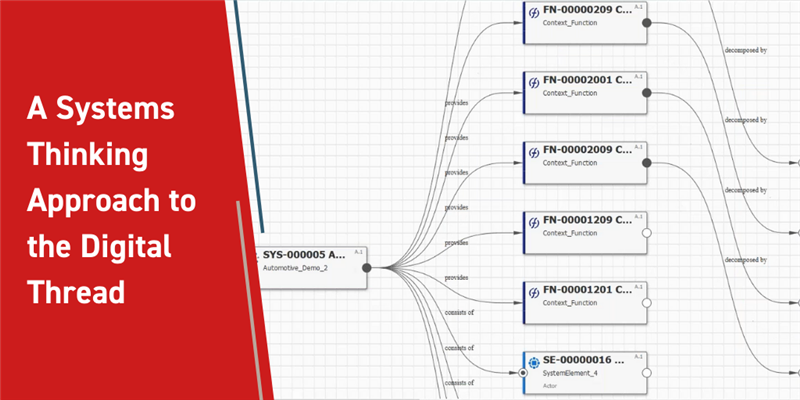The ability to maintain a system’s architecture as a single source of truth unifying all of its related engineering domains—requirements, simulation, mechanical, electronic and software— is critical to the development of complex products.
This was the subject of a recent Aras webinar, Connecting Systems Models and the Digital Thread with Aras Innovator. Three recently released applications—Requirements Engineering, Systems Architecture, and Simulation Management—tie closely with one another, with Product Engineering, and with other Aras platform applications and features to enable the modeling of a Digital Thread that connects your evolving product information across all lifecycle states—from early exploration to final asset disposal. This Digital Thread also eliminates the typical organizational and process siloes among requirements management, system modeling, and simulation.
See how the Aras Innovator platform does it, below:
The Power of the Digital Thread
The Digital Thread enables traceability and interoperability critical to managing complex designs across the entire product lifecycle. It is the key connection between iterative design loops that enable rapid early concept design and digital prototyping via simulation. And that's where the Aras platform comes in.
Requirements Engineering
Starting with the Requirements Engineering application in Aras Innovator, you can document design requirements and manage them throughout the product's lifecycle and across changes to the system. Requirements Documents aggregate all relevant requirements, while requirement parameters define precise values and units to track as the product evolves.
Systems Architecture
Systems Architecture manages the functional and logical breakdown of a system and its relationships to requirements, simulation studies ,and physical design. This domain, commonly known as systems engineering, is unique in Aras Innovator in that it includes synchronization with data generated by external system modeling tools and their related functional breakdown, requirements, and system context. It enables the management of more complex designs, including a consideration of how they operate within the broader context of the “system of systems” of which they are a part.
System model diagrams can be exposed in Aras Innovator as part of the data authored in external modeling tools. They are available for markup and collaboration across wider teams than just the systems engineering group, allowing for better visibility and closer collaboration than otherwise possible.
Simulation Management
Simulation Management in Aras Innovator manages artifacts and process metadata generated during any simulation and analysis methodology performed at any stage of the design: including exploration, system modeling, and detailed design. This discipline, commonly known as simulation process and data management (SPDM), is unique in Aras Innovator in that it organizes related simulation runs into studies: iterative, branching groups of tasks that capture the variables selected during individual simulation runs.
Variables across the design, environment, and simulation preparation steps or instructions can all be changed and compared between studies, all the while maintaining traceability back to the original requirements the study set out to measure. An intuitive Simulation Compare step lets engineers from any discipline easily interpret and leverage results to inform their work, improving systems designs and part selection decisions.
The Digital Thread in Aras Innovator: Visual, Interactive, and Integrated
Each of these applications easily integrates with external authoring tools, where changes made in the external tool propagate to Aras Innovator, and vice-versa. For system modeling tools, for example, key functional and logical elements that the user selects are kept in synch with the platform.
External and internal elements of the data model can be experienced visually in the Graph Navigation user interface: an interactive, graphical view into all of the data across a system. It demonstrates the connections among requirements, functional and logical system elements, simulation studies and parts information all managed on the Aras platform, even if they were originally generated in external tools. Graph Navigation comprises a rich user experience, where elements can be opened in context with this highly visual experience of the system's design.
The power to traverse, to interrogate, and to synchronize your system's evolving design across teams and tools accelerates design decisions and lends new insights to the teams designing today's highly complex, technologically advanced products.
For more information and a full, 30-minute demonstration, view the recent Aras webinar, Connecting Systems Models and the Digital Thread with Aras Innovator.

